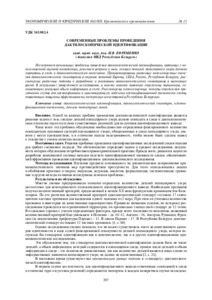Please use this identifier to cite or link to this item:
https://elib.psu.by/handle/123456789/19475Full metadata record
| DC Field | Value | Language |
|---|---|---|
| dc.contributor.author | Ефременко, Н. В. | - |
| dc.date.accessioned | 2017-03-03T11:34:24Z | - |
| dc.date.available | 2017-03-03T11:34:24Z | - |
| dc.date.issued | 2016 | - |
| dc.identifier.citation | Вестник Полоцкого государственного университета. Серия D, Экономические и юридические науки. - 2016. - № 13. – С. 207-210. | ru_RU |
| dc.identifier.issn | 2070-1632 | - |
| dc.identifier.uri | https://elib.psu.by/handle/123456789/19475 | - |
| dc.description | Modern Problems of Carrying Out Dactyloscopic Identification N. Efremenko | ru_RU |
| dc.description.abstract | Исследуются актуальные проблемы проведения дактилоскопической идентификации, связанные с количественной оценкой тождества, решением вопроса о том, сколько деталей папиллярного узора должно совпадать в следе и дактилоскопическом отпечатке. Проанализированы различные количественные значения дактилоскопических стандартов в странах западной Европы, США, России, Республики Беларусь, рассмотрены различные подходы к разработке и реализации дактилоскопических стандартов в настоящее время. В результате проведенного исследования, а также анализа практики определены параметры, составляющие реальный объем информации в следе. Рассмотрены количественные методы определения пригодности следов для идентификации и ориентирующего подсчета идентификационной значимости следов, позволяющие повысить эффективность экспертных исследований в Республике Беларусью.=The actual problems of carrying out dactyloscopic identification connected with a quantitative assessment of identity, the solution of a question of that how many details of a papillary pattern shall match in a trace and a dactyloscopic print are considered. Various quantitative values of dactyloscopic standards in countries of Western Europe, the USA, Russia, Republic of Belarus are analysed, various approaches to development and implementation of dactyloscopic standards are considered now. As a result of the conducted research, and also the analysis of practice the parameters constituting real amount of information in a trace are determined. The quantitative methods of determination of suitability of traces for identification, and the orienting calculation of the identification importance of traces allowing to increase efficiency of expert researches in the Republic of Belarus are considered. | ru_RU |
| dc.language.iso | ru | ru_RU |
| dc.publisher | Полоцкий государственный университет | ru_RU |
| dc.relation.ispartof | Веснік Полацкага дзяржаўнага ўніверсітэта. Серыя D, Эканамічныя і юрыдычныя навукі | be_BE |
| dc.relation.ispartof | Herald of Polotsk State University. Series D, Economics and law sciences | en_EN |
| dc.relation.ispartof | Вестник Полоцкого государственного университета. Серия D, Экономические и юридические науки | ru_RU |
| dc.relation.ispartofseries | Серия D, Экономические и юридические науки;2016. - № 13 | - |
| dc.rights | open access | ru_RU |
| dc.subject | Государственный рубрикатор НТИ - ВИНИТИ::ОБЩЕСТВЕННЫЕ НАУКИ::Государство и право. Юридические науки | ru_RU |
| dc.subject | дактилоскопическая идентификация | ru_RU |
| dc.subject | детали папиллярных линий | ru_RU |
| dc.subject | идентификационная значимость | ru_RU |
| dc.subject | dactyloscopic identification | ru_RU |
| dc.subject | dactyloscopic standard | ru_RU |
| dc.subject | details of papillary lines | ru_RU |
| dc.title | Современные проблемы проведения дактилоскопической идентификации | ru_RU |
| dc.type | Article | ru_RU |
| dc.identifier.udc | 343.982.4 | - |
| Appears in Collections: | 2016, № 13 | |
Files in This Item:
| File | Description | Size | Format | |
|---|---|---|---|---|
| 207-210.pdf | 155.25 kB | Adobe PDF |  View/Open |
Items in DSpace are protected by copyright, with all rights reserved, unless otherwise indicated.